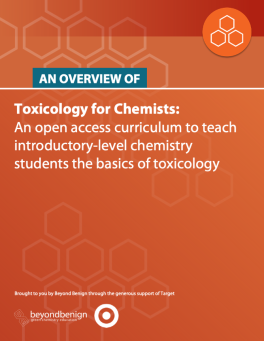01 - History and Principles of Toxicology - (Toxicology for Chemists Curriculum - Module 1)

Summary
This module serves as a good first introduction to toxicology. In the first part of the module, students will learn and understand: the history of toxicology and its underlying principles; the progression of toxicology as a science; the development of regulatory agencies; key case studies that developed the field; and the paradox of uncertainty. In the second part of the module, students will learn and understand: the general principles of toxicology; how dose determines the effect of a substance; and the factors that affect the toxicity of a chemical. There are multiple case studies throughout these slides.
What’s included?
Lectures:
“1AB – History of Toxicology” (2-3 hours)
“1C – Principles of Toxicology” (1-2 hours)
Lesson Plans:
For all lectures
Supplementary Information:
Two student assignments
File Size: 30 MB
This module was developed by:
Dr. Amy Cannon, Beyond Benign
And pilot tested by:
Dr. Cynthia Woodbridge, Georgia Gwinnett College
What’s included?
Lectures:
“1AB – History of Toxicology” (2-3 hours)
“1C – Principles of Toxicology” (1-2 hours)
Lesson Plans:
For all lectures
Supplementary Information:
Two student assignments
File Size: 30 MB
This module was developed by:
Dr. Amy Cannon, Beyond Benign
And pilot tested by:
Dr. Cynthia Woodbridge, Georgia Gwinnett College
Safety Precautions, Hazards, and Risk Assessment
N/A
Digital Object Identifier (DOI)
https://doi.org/10.59877/WNIO7276
File (PDF, PPT, image, etc)
Creative Commons License

This work is licensed under a Creative Commons Attribution-NonCommercial-ShareAlike 4.0 International License.


